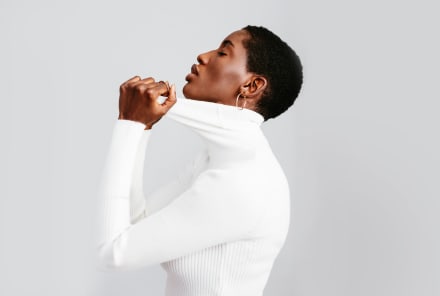Advertisement
Why Theta Brain Waves Are So Healing + How To Generate Them More Often


Our brains are complicated and multifaceted organs, to put it mildly. Aside from neurons, cells, blood vessels, and water, brain waves help compose the incredible masters of our central nervous system. These electrical voltages help our brains reach certain states1, from focused to relaxed.
Theta brain waves happen during a drowsy yet still awake period. Here's what you need to know about theta waves, including their relationship with sleep, and how you can tap into them to achieve your goals.
What are theta waves?
"Theta waves are one of the electrical patterns in the brain we see on a quantitative electroencephalogram (qEEG)—a test that measures electrical activity inside the brain," says communication pathologist and cognitive neuroscientist Caroline Leaf, Ph.D., author of Cleaning Up Your Mental Mess.
"Theta waves have a frequency of 4-8 Hz. and are activated when we are being insightful or creative. It's often referred to as the healing wave," Leaf adds.
Theta waves are very prevalent in children, says Ilene S. Ruhoy, M.D., Ph.D., a board-certified neurologist and medical director for the EDS/Chiari Center at Mount Sinai South Nassau Hospital in Hewlett, New York. However, they are also seen in adults in a non-alert, drowsy state where awareness of the physical world is lessened (such as hypnosis).
The fact that these waves are visible in both light sleep stages as well as during focused tasks is what makes them so interesting.
"Theta waves are the dominant frequency in healing, high creative states, remembering emotional experiences (good and bad), memory retrieval, and encoding new memories into thoughts," explains Leaf.
How brain waves work
All brain waves are measured using a qEEG. This test is conducted by placing electrodes on the person's scalp to measure electrical activity inside the brain as it responds to what the person is doing or thinking about.
"Typically, qEEG data is viewed onto a 'map' of the head, so we can see which areas of the brain have electrical activity, such as over the prefrontal cortex [PFC], amygdala, or hippocampus," says Leaf. "This also helps show which brain frequencies are more active and how they are working in relationship to each other."
There are five major types of brain waves, Ruhoy explains. Here's a quick breakdown of each:
- Gamma waves (> 25 Hz.): This is the fastest brain wave. It's responsible for learning, memory, and processing new information.
- Beta waves (> 13 Hz.): This brain wave is most prominent when we are awake and problem-solving or concentrating.
- Alpha waves (8–13 Hz.): This wave often occurs when we are awake and resting comfortably, responding to any visual stimulation, or actively thinking about something.
- Theta waves (4–8 Hz.): These occur when a person is in a light sleep stage or dreaming, as well as in a relaxed, meditative state of mind (commonly referred to as being on "autopilot").
- Delta waves (< 4 Hz.): These brain waves happen during deep sleep stages (think stage 3, or slow-wave sleep).
Can theta waves be manipulated?
Our brain waves can tell us a lot about how we're feeling and coping with stress. "Head maps produced from a qEEG can help tell us if someone is feeling anxious, burnt out, isn't managing stress, feels that their identity is being affected, is battling with executive functioning, and more," says Leaf.
On the other hand, she says they also show when a person is in control of their mind, processing their issues, and learning new ways of thinking.
With this in mind, if someone is looking to feel less stressed, is it possible to encourage theta waves for more relaxation? Some science suggests yes.
For example, research published in Neuroscience & Biobehavioral Reviews states that a systematic review of 56 studies including 1,715 people determined that mindfulness meditation was commonly associated with an increase in theta waves2—more so than if the person was just resting with their eyes closed, not actively meditating.
"Theta waves can be manipulated through meditation," reiterates Ruhoy. "Depending on how deep the meditation is, it can create theta bursts or rhythmic chains of theta waves. There is some evidence that with true and deep meditation, theta waves can persist3 even after meditation is complete."
Auditory forms of mindfulness like sound bathing may also be useful for encouraging theta waves. Research published in Neuron suggests that certain rhythmic sounds can increase theta waves4, which may then boost memory retention and concentration even after the listening session ends.
"Theta wave pattern activity highlights the interaction that happens between the conscious and nonconscious mind as we think deeply," says Leaf. "This is a pattern that we want to see in our brain because it reflects improving mind management."
Any time a person intentionally builds new memory or has meaningful introspection, she adds that there will also be an increase in theta wave activity.
Take the quiz
Theta waves & sleep
Theta waves are a common marker of drowsiness, says Ruhoy, and they are often present as we transition between an awake state and a sleep state.
But theta waves are also a big part of the rapid eye movement (REM) sleep stage, which occurs about 90 minutes after falling asleep. This is the stage of sleep where vivid dreams may occur.
"Dreams can be influenced by how we manage our minds during the day," says Leaf. "When we go to sleep after successfully handling stress or combating intrusive thoughts, we get more theta activity. This increases the benefits from REM sleep and helps regenerate the mind, brain, and body to prepare us for the next day."
Theta waves & manifestation
When it comes to visualizing your goals to bring them to life, both Leaf and Ruhoy say that harnessing theta waves can help.
"The more you deliberately practice creativity, self-regulation, and brain-building (practicing deep thinking and learning daily), the more theta frequency is increased, especially at frontal sites during activities that require attention or short-term memory," says Leaf.
"It's important to remember that theta waves are an energy response to mind activity, and the way we manage our minds will result in optimal theta responses," she adds.
Ruhoy reiterates that meditation is key when it comes to promoting theta waves and getting us into a receptive state of consciousness.
"This state is where our true authenticity lies and where we can find our connection to the universe and know the core of who we are, what we want, and what we need to be," she says. Once we get into this state, manifesting may become easier.
The bottom line
We all experience theta wave activity without even thinking about it. But neuroscience experts say that actively flexing your creativity, learning new skills, doing inner work, meditating, and listening to healing sounds can help you reach this calm state of mind more regularly—and get all the benefits that come with it.


















